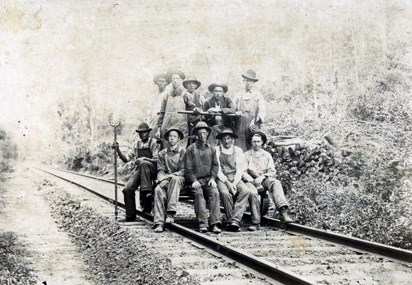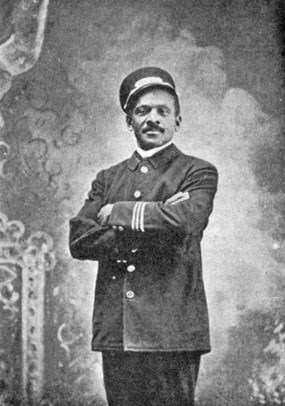
The Gauley Bridge Railroad Station was constructed in 1893. It is one of the pre-designed “company trademark” stations built in small communities throughout West Virginia during this time. It has a rectangular wood frame structure and a hipped slate roof. Its gabled bay window, centered in the north façade facing the tracks, was the focal point of all station activity. Construction of railroads and stations brought thousands of people to the coal-rich region of Appalachia. Three railroads opened the vast coalfields of Southern West Virginia to mining: the Chesapeake & Ohio Railway along the New and Kanawha rivers, the Norfolk & Western Railway through the Pocahontas coalfield, and the Virginian Railway into the Winding Gulf fields. This meant jobs building and maintaining the railroads as well as jobs in the coal mines. Jobs in these industries provided the opportunity for African American families to escape the “Jim Crow” segregated society of the Deep South. African American men were able to build new lives as vital, more respected, and better-paid workers. 
"They have proved in fact to be fine laborers, both as track-makers, and for mining, blasting, and all the other work of railroad building. They lived in shanties along the road, wherever their work lay … It [the road] was built almost entirely by the labor of negroes, who here proved themselves admirable and trustworthy workmen; sober, equal to the severest toil, and winning the good opinion of everyone. These blacks, of whom five thousand were employed on the road, [were] all formerly slaves in Eastern Virginia …”1 After construction was completed, the depot and rail yard here at Gauley Bridge, as at other towns along the rails, continued to provide African Americans with steady jobs. Maintaining the tracks was called “lining track.” It was a daily, hard-labor; a never-ending task primarily accomplished by black work crews. Often known as “gandy dancers” these men used songs and rhythm as a choreographed team. They aligned the track with precision, placing heavy wooden ties and steel rails, and driving in spikes. 
Following the Civil War, George Pullman established the Pullman Sleeping Car Company. Pullman sleeper cars were contracted out to all the passenger railways in the United States and the porters hired to staff the sleepers were exclusively black. The Pullman Company grew to be the largest single employer of African Americans in the nation. In 1925, Pullman porters formed the first all-black union, the Brotherhood of Sleeping Car Porters. Although the railroad provided employment opportunities for African Americans, these jobs often required the hardest work while providing the lowest pay. Even with these challenges and the limitations of a segregated society, African American railroad men worked hard to provide for their families, and built strong black communities through church, school, and civic organizations. 1 Christopher Wilkinson, Big Band Jazz in Black West Virginia, 1930-1942, University Press of Mississippi, Jackson, 12-13. |
Last updated: January 22, 2020
